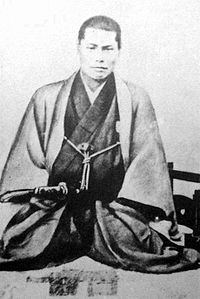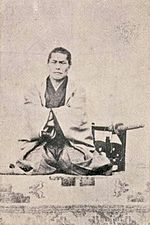Kondō Isami
Kondō Isami ( Japanese 近藤 勇 ; born October 9, 1834 in Kami-Ishihara, Musashi Province (today: Chōfu , Tokyo Prefecture ); † April 25, 1868 near Itabashi ) was a samurai of the Bakumatsu era and captain of the police unit stationed in Kyoto Shinsengumi .
origin
Kondō Isami was born in 1834 as the third son of the farmers Miyagawa Kyūjirō ( 宮 川 久 次郎 ) and Miyagawa Miyo under the name Miyagawa Katsugorō ( 宮 川 勝 五郎 ) in the village of Kami-Ishihara (now part of the city of Chōfu in Tokyo Prefecture ) in the Tama district of the province Musashi born. His oldest brother was called Otogorō , the second oldest Kumejirō (or Kumezō ). He also had an older sister who died when he was very young. His mother also died very early. Kondō is said to have been an avid book reader, in particular The Story of the 47 Rōnin and The Story of the Three Realms are said to have been among his favorite books. He was considered a scholar in his village. As a child, Kondo is said to have been a troublemaker, but he is said to have never annoyed younger children.
When he defeated a gang of thieves who had broken into his family home, it brought him the attention of Kondō Shūsuke (also Shūsai). He was the third head of the Tennen Rishin-ryū sword school and adopted Miyagawa in 1849, who then took the name Shimazaki Katsuta and later renamed himself Kondō Isami. In August 1861, Kondō Isami took over as the fourth head of the school and thus the associated Shieikan Dōjō .
Historical situation
The continuous opening of Japan that began with the arrival of Matthew Perry in the 1860s caused much controversy among the population. As a result, various military movements emerged that sparked great unrest in the country. Some fought for the opening of Japan and the associated maintenance of power of the Tokugawa shogunate . Others, the Shishi , for example, made themselves known with the slogan Sonnō-jōi and demanded that power be returned to the Tennō , the Japanese emperor, and thus voted against the western foreign countries.
Shinsengumi
When Matsudaira Tadatoshi gathered Rōnin in 1863 to protect Shōgun Iemochi during his stay in Kyoto, Kondō as well as students and guests of the Shieikan Dōjo decided to follow this call. Among them were Hijikata Toshizō , Yamanami Keisuke , Okita Sōji , Harada Sanosuke , Nagakura Shinpachi , Tōdō Heisuke and Inoue Genzaburō . They joined forces with others to form Rōshigumi (also called Rōshitai). When their leader Kiyokawa Hachirō revealed to them that the group should turn their activities against the Shogun, the group around Kondō left the Rōshitai with him. In Kyoto they founded the Mibu Rōshigumi , which was under the command of the Aizu clan . The name was later changed to Shinsengumi . As such, they were officially used as the Kyoto Police Department and became famous and infamous. Kondō Isami initially held the post of commander together with Serizawa Kamo and Niimi Nishiki , but after the latter had to commit seppuku after improper behavior , he led the Shinsengumi with the support of his vice-commanders Hijikata and Yamanami alone.
death
The power struggle between Shogun and Tenno was decided in the Boshin War in 1868/69 . With the defeat of the Shogun, the Shinsengumi was expelled from Kyoto. The unit fought on until it surrendered temporarily after the Battle of Toba-Fushimi and surrendered Isami Kondo to the imperial troops at Nagareyama in Shimousa Province . He was arrested and beheaded at Itabashi in April 1868 . It is reported that he asked to be allowed to commit seppuku , but was refused because he originally came from a farming family.
His head was later shown in Kyoto, but it is not known exactly where the head and corpse were afterwards. There are several tombstones, the first is said to have been erected in Aizu by his best friend Hijikata. There is also a memorial stone in his and Hijikata Toshizō's honor near the Itabashi subway station in Tokyo . A tomb is located in the Ryūgan-ji Temple in Mitaka , Tokyo.
To person
Kondō is said to have been a rather calm and sociable man, historians are of the opinion that the strict leadership of the Shinsengumi can be traced back to Hijikata. It is known that he could put his whole fist in his mouth, and sometimes did so to impress others.
Kondō Isami was married and had a daughter who was born in 1862. Both were killed in the riots of the 1860s, as was his grandson, who was killed in the Sino-Japanese War .
media
Shinsengumi is a very popular theme in Japanese anime. Kondō emerged both in Gintama (銀魂, "Silver Soul") and Bakumatsu Kikansetsu Irohanihoheto (幕末機関説いろはにほへと"The confirmation of the end of the shogunate is just two steps behind the door") and in Mutsu Enmei Ryuu Gaiden: Shura no Toki on .
swell
- Romulus Hillsborough : The Shogun's Last Samurai Corp. Tuttle Publishing, 2005, ISBN 0-8048-3627-2
- S. Noma (Ed.): Kondō Isami . In: Japan. An Illustrated Encyclopedia. Kodansha, 1993. ISBN 4-06-205938-X , p. 823.
Web links
| personal data | |
|---|---|
| SURNAME | Kondō, Isami |
| ALTERNATIVE NAMES | 近藤 勇 (Japanese); Miyagawa Katsugorō (childhood name); 宮 川 勝 五郎 (childhood name, Japanese) |
| BRIEF DESCRIPTION | Captain of the Shinsengumi, a Japanese protection force |
| DATE OF BIRTH | October 9, 1834 |
| PLACE OF BIRTH | Kami-Ishihara |
| DATE OF DEATH | April 25, 1868 |
| Place of death | Itabashi |

